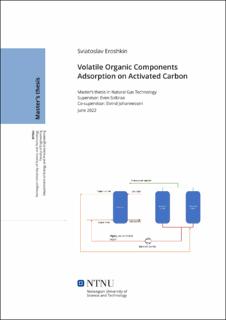| dc.description.abstract | Some volatile organic components may cause serious human health and environmental threats. These components are "global warming agents" that contribute to climate change. While the negative impact of methane and carbon dioxide on climate is highly studied, the influence of non-methane volatile organic components is less known. These gases affect the earth-atmosphere energy balance by the production of ozone and a reaction with the hydroxyl radical, which in turn leads to a longer atmospheric lifetime of methane. A more efficient purifying is thus becoming critical for companies that use such components in their processes. Adsorption is one of the most used techniques for this.
The proper development of the adsorption process with high performance involves the design of a model that can describe the dynamic of adsorption, considering all relevant transport phenomena.
The primary purpose of the study is to simulate the adsorption of methane, ethane, propane, butane, nitrogen, and carbon dioxide on an activated carbon bed. The vacuum pressure swing adsorption model in Python is developed. It is based on the Extended Langmuir isotherm, a linear driving force approximation for mass transfer, and mass, momentum, and energy balance equations. One cycle consists of 4 steps: co-current pressurization, adsorption, counter-current blowdown, and counter-current nitrogen purge. The model is validated by comparison with the commercial software Aspen Adsorption and available experimental results. An experimental comparison is implemented with multi-component and two-component adsorption results. Still, some adjustments are required to get a good comparison with experimental data. Furthermore, it was shown that the model gives a good result with adsorption phenomena understanding. The model has been applied to analyze the adsorption dependence on various crucial parameters, such as adsorption and desorption pressure, inlet and purge gas flow rates, adsorption step time. | |
